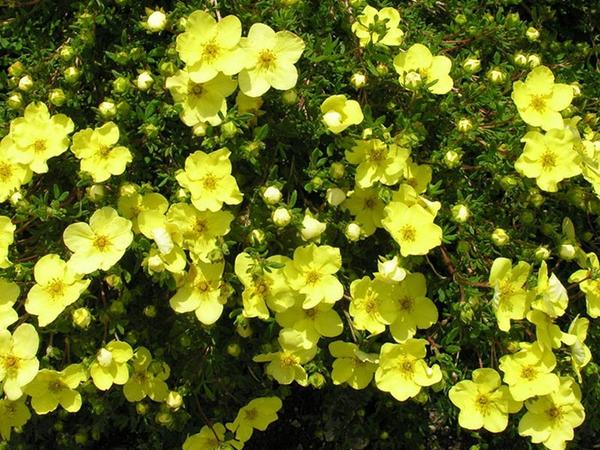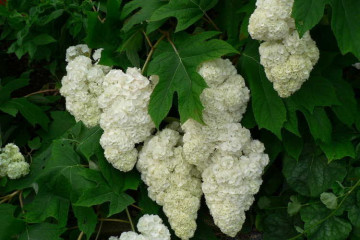Herb cinquefoil - planting and care
Content:
This decorative type has more than 300 varieties. Herbaceous cinquefoil is used by gardeners to decorate gardens and summer cottages. Divided into annuals and perennials. The plant has gained popularity due to its unpretentious care.
Description of herbaceous cinquefoil
Perennial Potentilla is a hybrid plant. The height of the bush varies from 10 to 30 cm. Straight stems are equipped with creeping nodes. The leaves can be of different types: trifoliate, pinnate, and palmate. The inflorescence is solitary, sometimes many-flowered. The fruit is a nutlet located on a receptacle.
Herbal cinquefoil is represented by several of the most popular types:
- Golden cinquefoil is a perennial plant. A low bush 10-30 cm high. Flowers are small - 2 cm. The color of the inflorescences is golden yellow. Blooms from July to August. It perfectly tolerates even the strongest frosts.
- Blood red cinquefoil is a herbaceous plant reaching 90 cm. The flowers are small, painted in a rich red color. It tolerates winter frosts well.
- Cinquefoil "Carmen". The variety got its name because of its very beautiful large red flowers with pronounced stamens. The plant is not afraid of either frost or drought.
- White cinquefoil is the smallest representative of this variety. The flowers are white. The main property of this species is that the peduncles are tall, the stem leaves are absent.
Planting a plant
For a plant, cinquefoil is herbaceous perennial planting and care does not require special professional skills. Feels good in the shady areas of the garden, grows even on "poor" soil. The correct place should be well lit for at least 6 hours a day.
Planting from seeds
For growing seedlings, seeds are laid out in containers with nutrient soil, sprinkled with sand and watered. The containers are covered with glass or foil. When the first leaves appear, the film is removed.
Planting seedlings in open ground
After 60 days, young grass is planted in open ground.
Potentilla seeds are best planted in the ground in spring. Seeds are sown on the pre-moistened soil and sprinkled with river sand. After the sprouts appear, the main thing is to water and remove weeds in a timely manner.
How to care for herbaceous cinquefoil
Taking care of this plant is not difficult at all. It is necessary to follow the rules of watering, feeding. Carry out timely sanitary pruning of the plant.
Watering
Maintaining constant moisture under the bush is the key to abundant flowering and active growth of Potentilla. Watering is carried out with warm water. After moistening the earth, the soil must be loosened and mulched.
Top dressing
The plant loves enriched soil. In the spring, it is necessary to add 40 g of potassium sulfate and 30 g of phosphate fertilizer to the ground. The mixture is diluted in 10 liters of warm water and poured under each bush.
To maintain the plant during flowering, phosphorus-potassium fertilizer is added to the soil.
Pruning
In the fall, sanitary pruning of any shrub involves the removal of all diseased and old shoots. In spring, branches are cut 2/3 of their length.
To form a decorative look from Potentilla, you can create any shape.
Reproduction methods
There are 5 ways to reproduce Potentilla:
- For propagation by seeds directly into the ground, mid-May is best suited. The soil should be light and nutritious.
- Seedlings are grown from seeds that are sown in a special container.
- For dividing by cuttings, a 10 cm long branch is cut off from an adult bush. The lower part of the planting material is processed by Kornevin and planted in a special pit filled with drainage.
- Layers. The lower branch of the bush is gently laid aside and buried in. The offspring should be in the most nutritious and moist soil.
- Only an adult plant can be divided. The bush is dug up, the root system is divided into the required number of parts.
Transfer
The plant is transplanted with a mandatory depth of 60 cm and 30 cm between flowers. The pit is drained and filled with light soil. When transplanting, it is important not to deepen the root part. After planting, the plant is abundantly watered and mulched.
Diseases and pests
In most cases, this species is not susceptible to diseases and pests.
There are isolated cases of rust damage to the plant. Outwardly, the disease manifests itself in the form of orange spots on the leaves and stem.
The appearance of the fungus is due to high humidity and a sharp cold snap. At the first signs of infection, the bush should be sprayed with a 1% solution of Bordeaux liquid or "Fufanon".
Flowering period
The shrub blooms throughout the summer (from May to September). Depending on the species, flowers can be surrounded by regular or hairy receptacles. The fruit can be of different sizes and filled with different numbers of achenes.
Preparing for winter
After sanitary pruning, the young bush is processed with copper sulfate and covered with any agricultural canvas. Adult plants do not need protection.
Use in landscape design
Low-growing types of Potentilla are used to fill empty spaces on the site. For compositions, the tall variety blends nicely with small neighbors.
A flowering hedge can be made from a shrub by simply planting seedlings in a row. Weaving plant species are used by professionals for the design of high flower beds and gazebos.
Nursing and planting jobs are easy. The main thing is to follow all these simple rules. With careful attention, the bushes will bloom profusely and delight with their grace.






















